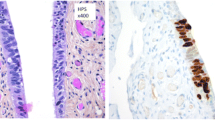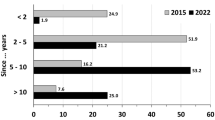Abstract
Background
Opportunistic bilateral salpingectomy (OBS), also called as prophylactic salpingectomy or risk-reducing salpingectomy is the concurrent removal of the fallopian tubes in premenopausal women. Though there are some studies comparing the intraoperative complications and effect of salpingectomy on ovarian reserve, limited data are available on long-term follow-up after OBS.
Purpose of the Study
To evaluate the surgical outcome of routine bilateral salpingectomy during total laparoscopic hysterectomy (TLH) in terms of intraoperative and postoperative complications. We also evaluated the incidence and reoperation rate for adnexal pathology after TLH.
Methods
A retrospective study of 1470 patients undergoing total laparoscopic hysterectomy (TLH) with opportunistic bilateral salpingectomy (OBS) over 13 years was carried out at Paul’s Hospital.
Results
The mean age of the subjects was 43.6 ± 4.2 years, mean body mass index was 27 ± 5.4 kg/m2, and median parity was 2 (range 0–7). 43% of women had at least one previous surgery. The most common indication for surgery was fibroid uterus (67%, n = 985). The total complication rate was 4.4% (n = 65). One specimen showed paratubal borderline serous malignancy. The follow-up period ranged from 6 months to 13 years during which 17 (1.1%) women had adnexal pathology, and eight women (1.1%) needed resurgery for it. No ovarian malignancies were reported on follow-up.
Conclusions
OBS is a simple and short surgical step during TLH without increasing morbidity. OBS eliminates the risk of future diseases of tubal origin, and there might be a possible reduction in incidence and reoperation rate for future ovarian pathologies.
Similar content being viewed by others
References
Vorwergk J, Radosa MP, Nicolaus K, et al. Prophylactic bilateral salpingectomy (PBS) to reduce ovarian cancer risk incorporated in standard premenopausal hysterectomy: complications and re-operation rate. J Cancer Res Clin Oncol. 2014;140:859–65.
Ghezzi F, Cromi A, Siesto G, Bergamini V, Zefiro F, Bolis P. Infectious morbidity after total laparoscopic hysterectomy: does concomitant salpingectomy make a difference? BJOG Int J Obstet Gynaecol. 2009;116:589–93.
Gill SE, Mills BB. Physician opinions regarding elective bilateral salpingectomy with hysterectomy and for sterilization. J Minim Invasive Gynecol. 2013;20:517–21.
Yoon SH, Kim SN, Shim SH, Kang SB, Lee SJ. Bilateral salpingectomy can reduce the risk of ovarian cancer in the general population: a meta-analysis. Eur J Cancer. 2016;55:38–46.
Hanley GE, McAlpine JN, Kwon JS, Mitchell G. Opportunistic salpingectomy for ovarian cancer prevention. Gynecol Oncol Res Pract. 2015;2:5.
Caprini JA, Arcelus JI, Reyna JJ. Effective risk stratification of surgical and nonsurgical patients for venous thromboembolic disease. Semin Hematol. 2001;38(2 Suppl 5):12–9.
Clavien PA, Barkun J, de Oliveira ML, et al. The Clavien–Dindo classification of surgical complications: five-year experience. Ann Surg. 2009;250(2):187–96.
Ferlay J, Soerjomataram I, Dikshit R, et al. Cancer incidence and mortality worldwide: sources, methods and major patterns in GLOBOCAN 2012. Int J Cancer. 2014;136(5):E359–86. https://doi.org/10.1002/ijc.29210.
Erickson BK, Conner MG, Landen CN Jr. The role of the fallopian tube in the origin of ovarian cancer. Am J Obstet Gynecol. 2013;209:409–14. https://doi.org/10.1016/j.ajog.2013.04.019.
Minig L, Chuang L, Patrono MG, Cárdenas-Rebollo JM, García-Donas J. Surgical outcomes and complications of prophylactic salpingectomy at the time of benign hysterectomy in premenopausal women. J Minim Invasive Gynecol. 2015;22:653–7.
Berlit S, Tuschy B, Kehl S, Brade J, Sutterlin M, Hornemann A. Laparoscopic supracervical hysterectomy with concomitant bilateral salpingectomy–why not? Anticancer Res. 2013;33(6):2771–4.
Selcuk I, Boyraz G, Esinler I. Adnexal torsion in a perimenopausal woman after laparoscopic hysterectomy: case report. Turkiye Klinikleri Jinekoloji Obstetrik. 2013;23:127–30.
Kotlyar A, Gingold J, Shue S, Falcone T. The effect of salpingectomy on ovarian function. J Minim Invasive Gynecol. 2017;24(4):563–78.
Guldberg R, Wehberg S, Skovlund CW, Mogensen O, Lidegaard O. Salpingectomy as standard at hysterectomy? A Danish cohort study, 1977–2010. BMJ Open. 2013;3:e002845.
Author information
Authors and Affiliations
Corresponding author
Ethics declarations
Conflict of interest
The authors declared that they have no conflict of interest.
Ethics Committee Approval
Written informed consent was obtained from the patients for publication. The retrospective observational nature of the study did not necessitate the local institutional ethics committee approval.
Additional information
Dr. P.G. Paul, M.B.B.S., D.G.O., is a Consultant Gynecologist and Endoscopic Surgeon at Centre for Advanced Endoscopy and Infertility Treatment, Paul’s hospital, Vattekkattu Road, Kaloor, Kochi, Kerala, 682 017, India. Dr. Sumina Mannur, M.B.B.S., M.S., D.N.B., is a Assistant Gynecologist at Centre for Advanced Endoscopy and Infertility Treatment, Paul’s hospital, Vattekkattu Road, Kaloor, Kochi, Kerala, 682 017, India. Dr. Hemant Shintre, M.B.B.S., D.G.O., D.N.B., is a Assistant Gynecologist at Centre for Advanced Endoscopy and Infertility Treatment, Paul’s hospital, Vattekkattu Road, Kaloor, Kochi, Kerala, 682 017, India. Dr. George Paul, M.B.B.S., M.S., is a Assistant Gynecologist at Centre for Advanced Endoscopy and Infertility Treatment, Paul’s hospital, Vattekkattu Road, Kaloor, Kochi, Kerala, 682 017, India. Dr. Gunjan Gulati, M.B.B.S., M.S., is a Assistant Gynecologist at Centre for Advanced Endoscopy and Infertility Treatment, Paul’s hospital, Vattekkattu Road, Kaloor, Kochi, Kerala, 682 017, India. Dr. Santwan Mehta, M.B.B.S., M.S., is a Assistant Gynecologist at Centre for Advanced Endoscopy and Infertility Treatment, Paul’s hospital, Vattekkattu Road, Kaloor, Kochi, Kerala, 682 017, India.
Rights and permissions
About this article
Cite this article
Paul, P.G., Mannur, S., Shintre, H. et al. Thirteen Years of Experience with Opportunistic Bilateral Salpingectomy During TLH in Low-Risk Premenopausal Women. J Obstet Gynecol India 68, 314–319 (2018). https://doi.org/10.1007/s13224-018-1131-7
Received:
Accepted:
Published:
Issue Date:
DOI: https://doi.org/10.1007/s13224-018-1131-7




